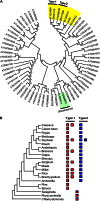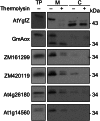Identification of mitochondrial coenzyme a transporters from maize and Arabidopsis
- PMID: 23590975
- PMCID: PMC3668054
- DOI: 10.1104/pp.113.218081
Identification of mitochondrial coenzyme a transporters from maize and Arabidopsis
Abstract
Plants make coenzyme A (CoA) in the cytoplasm but use it for reactions in mitochondria, chloroplasts, and peroxisomes, implying that these organelles have CoA transporters. A plant peroxisomal CoA transporter is already known, but plant mitochondrial or chloroplastic CoA transporters are not. Mitochondrial CoA transporters belonging to the mitochondrial carrier family, however, have been identified in yeast (Saccharomyces cerevisiae; Leu-5p) and mammals (SLC25A42). Comparative genomic analysis indicated that angiosperms have two distinct homologs of these mitochondrial CoA transporters, whereas nonflowering plants have only one. The homologs from maize (Zea mays; GRMZM2G161299 and GRMZM2G420119) and Arabidopsis (Arabidopsis thaliana; At1g14560 and At4g26180) all complemented the growth defect of the yeast leu5Δ mitochondrial CoA carrier mutant and substantially restored its mitochondrial CoA level, confirming that these proteins have CoA transport activity. Dual-import assays with purified pea (Pisum sativum) mitochondria and chloroplasts, and subcellular localization of green fluorescent protein fusions in transiently transformed tobacco (Nicotiana tabacum) Bright Yellow-2 cells, showed that the maize and Arabidopsis proteins are targeted to mitochondria. Consistent with the ubiquitous importance of CoA, the maize and Arabidopsis mitochondrial CoA transporter genes are expressed at similar levels throughout the plant. These data show that representatives of both monocotyledons and eudicotyledons have twin, mitochondrially located mitochondrial carrier family carriers for CoA. The highly conserved nature of these carriers makes possible their reliable annotation in other angiosperm genomes.
Figures






Similar articles
-
Identification of mitochondrial thiamin diphosphate carriers from Arabidopsis and maize.Funct Integr Genomics. 2012 Jun;12(2):317-26. doi: 10.1007/s10142-012-0273-4. Epub 2012 Mar 18. Funct Integr Genomics. 2012. PMID: 22426856
-
The mitochondrial NAD+ transporter (NDT1) plays important roles in cellular NAD+ homeostasis in Arabidopsis thaliana.Plant J. 2019 Nov;100(3):487-504. doi: 10.1111/tpj.14452. Epub 2019 Aug 9. Plant J. 2019. PMID: 31278825 Free PMC article.
-
Chloroplast β-barrel proteins are assembled into the mitochondrial outer membrane in a process that depends on the TOM and TOB complexes.J Biol Chem. 2012 Aug 10;287(33):27467-79. doi: 10.1074/jbc.M112.382093. Epub 2012 Jun 28. J Biol Chem. 2012. PMID: 22745120 Free PMC article.
-
Arabidopsis genes encoding components of the chloroplastic protein import apparatus.Plant Physiol. 2001 Apr;125(4):1567-76. doi: 10.1104/pp.125.4.1567. Plant Physiol. 2001. PMID: 11299338 Free PMC article. Review.
-
Transport of adenine nucleotides in the mitochondria of Saccharomyces cerevisiae: interactions between the ADP/ATP carriers and the ATP-Mg/Pi carrier.Mitochondrion. 2009 Apr;9(2):79-85. doi: 10.1016/j.mito.2009.01.001. Epub 2009 Jan 17. Mitochondrion. 2009. PMID: 19460304 Review.
Cited by
-
Characterization of In Vivo Function(s) of Members of the Plant Mitochondrial Carrier Family.Biomolecules. 2020 Aug 24;10(9):1226. doi: 10.3390/biom10091226. Biomolecules. 2020. PMID: 32846873 Free PMC article. Review.
-
Mitochondrial transport and metabolism of the vitamin B-derived cofactors thiamine pyrophosphate, coenzyme A, FAD and NAD+ , and related diseases: A review.IUBMB Life. 2022 Jul;74(7):592-617. doi: 10.1002/iub.2612. Epub 2022 Mar 18. IUBMB Life. 2022. PMID: 35304818 Free PMC article. Review.
-
Divisions of labor in the thiamin biosynthetic pathway among organs of maize.Front Plant Sci. 2014 Aug 4;5:370. doi: 10.3389/fpls.2014.00370. eCollection 2014. Front Plant Sci. 2014. PMID: 25136345 Free PMC article.
-
The Main Functions of Plastids.Methods Mol Biol. 2024;2776:89-106. doi: 10.1007/978-1-0716-3726-5_5. Methods Mol Biol. 2024. PMID: 38502499 Review.
-
Power(2): the power of yeast genetics applied to the powerhouse of the cell.Trends Endocrinol Metab. 2015 Feb;26(2):59-68. doi: 10.1016/j.tem.2014.12.002. Epub 2015 Jan 12. Trends Endocrinol Metab. 2015. PMID: 25591985 Free PMC article. Review.
References
-
- Agrimi G, Russo A, Pierri CL, Palmieri F. (2012a) The peroxisomal NAD+ carrier of Arabidopsis thaliana transports coenzyme A and its derivatives. J Bioenerg Biomembr 44: 333–340 - PubMed
-
- Agrimi G, Russo A, Scarcia P, Palmieri F. (2012b) The human gene SLC25A17 encodes a peroxisomal transporter of coenzyme A, FAD and NAD+. Biochem J 443: 241–247 - PubMed
-
- Bedhomme M, Hoffmann M, McCarthy EA, Gambonnet B, Moran RG, Rébeillé F, Ravanel S. (2005) Folate metabolism in plants: an Arabidopsis homolog of the mammalian mitochondrial folate transporter mediates folate import into chloroplasts. J Biol Chem 280: 34823–34831 - PubMed
-
- Bernhardt K, Wilkinson S, Weber AP, Linka N. (2012) A peroxisomal carrier delivers NAD+ and contributes to optimal fatty acid degradation during storage oil mobilization. Plant J 69: 1–13 - PubMed
Publication types
MeSH terms
Substances
Associated data
- Actions
- Actions
- Actions
- Actions
- Actions
LinkOut - more resources
Full Text Sources
Other Literature Sources
Molecular Biology Databases

